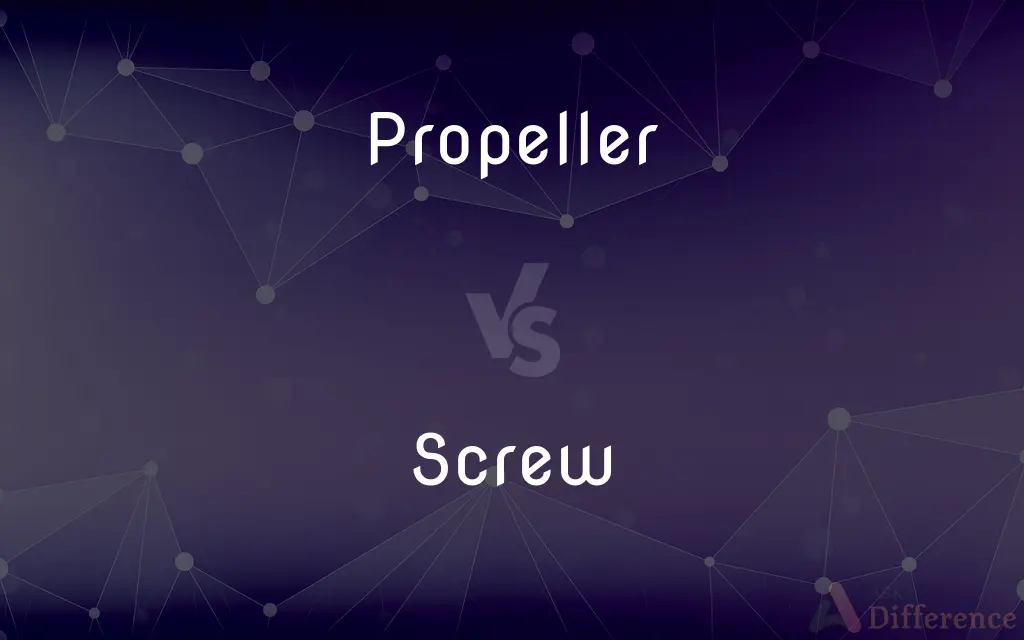Propeller vs. Screw — What's the Difference?
By Urooj Arif & Fiza Rafique — Updated on March 27, 2024
A propeller converts rotational motion into thrust in a fluid, mainly used in boats and airplanes, whereas a screw, a simple machine, converts rotational motion into linear force, primarily for fastening or lifting.

Difference Between Propeller and Screw
Table of Contents
ADVERTISEMENT
Key Differences
Propellers are devices with blades that spin around a central shaft, designed to move through a fluid (air or water) and generate thrust by pushing against the fluid. This action propels vehicles such as boats, submarines, and airplanes forward. The design and efficiency of a propeller depend on the shape, size, and number of its blades, as well as the speed at which it rotates. On the other hand, a screw is a type of fastener, essentially an inclined plane wrapped around a cylinder, used to hold objects together or to lift heavy loads by converting rotational motion into linear motion.
While propellers are evaluated based on their ability to convert engine power into thrust efficiently, thereby determining the speed and maneuverability of the vehicle, screws are judged by their strength, the holding power, and the precision with which they can convert rotary motion into linear displacement. Propellers are critical components in the design of various modes of transport, playing a key role in determining their performance characteristics. Conversely, screws are ubiquitous in construction, machinery, and many aspects of daily life, serving as fundamental tools in assembly and mechanical design.
In terms of physical principles, a propeller operates by exploiting Newton's third law of motion, generating thrust opposite to the direction of the fluid it displaces. This is a dynamic interaction between the propeller and the fluid environment. Screws, however, rely on the mechanical advantage provided by the inclined plane principle, where a small rotational force applied at the screw's head can produce a much larger linear force at the tip, making it easier to bind materials together or lift an object.
The manufacturing and design considerations for propellers and screws also differ significantly. Propellers must be precisely engineered to minimize drag and maximize efficiency in fluid dynamics, often requiring materials that can withstand high forces and corrosive environments. Screws, in contrast, might be made from a variety of materials based on the application, with design considerations focusing on thread type, length, diameter, and the material's tensile strength.
Comparison Chart
Function
Converts rotational motion into thrust in a fluid.
Converts rotational motion into linear force.
ADVERTISEMENT
Primary Use
Propulsion of vehicles like boats, airplanes.
Fastening objects together, lifting.
Operating Principle
Newton's third law of motion (action and reaction).
Mechanical advantage of the inclined plane.
Design Considerations
Blade shape, size, number, material for efficiency in fluid.
Thread type, length, diameter, material for strength, precision.
Impact
Affects speed, efficiency, and maneuverability of vehicles.
Essential for assembly, construction, and mechanical designs.
Compare with Definitions
Propeller
Designed based on fluid dynamics for efficiency.
Advanced propellers use composite materials for better performance.
Screw
An inclined plane wrapped around a cylinder, used as a fastener.
The carpenter tightened the screw to secure the hinge.
Propeller
A device with rotating blades, used to propel a vehicle through air or water.
The boat's propeller was entangled with seaweed.
Screw
Varies in size and thread design for different applications.
The construction required heavy-duty screws for structural support.
Propeller
A key component in marine and aviation vehicles.
The submarine's silent propeller technology makes it nearly undetectable.
Screw
Converts rotational motion to linear force, mainly for fastening.
Precision screws are vital for assembling electronics.
Propeller
Converts engine rotational power into thrust.
Aircraft propellers are designed for optimal air propulsion.
Screw
Essential for mechanical lifting and holding components together.
The jack's screw mechanism lifted the car effortlessly.
Propeller
Influences vehicle speed and fuel consumption.
Replacing the old propeller significantly improved the ship's speed.
Screw
Found in countless applications from construction to machinery.
The engineer selected a specific screw type for the aerospace part.
Propeller
A propeller is a device with a rotating hub and radiating blades that are set at a pitch to form a helical spiral, that, when rotated, exerts linear thrust upon a working fluid, such as water or air. Propellers are used to pump fluid through a pipe or duct, or to create thrust to propel a boat through water or an aircraft through air.
Screw
A screw and a bolt (see Differentiation between bolt and screw below) are similar types of fastener typically made of metal and characterized by a helical ridge, called a male thread (external thread). Screws and bolts are used to fasten materials by the engagement of the screw thread with a similar female thread (internal thread) in the matching part.
Propeller
A mechanical device for propelling a boat or aircraft, consisting of a revolving shaft with two or more broad, angled blades attached to it.
Screw
A cylindrical rod incised with one or more helical or advancing spiral threads, as a lead screw or worm screw.
Propeller
A device for propelling an aircraft or boat, consisting of a spinning shaft with radiating angled blades that thrust air or water in the direction opposite the desired direction of travel.
Screw
The tapped collar or socket that receives this rod.
Propeller
One who, or that which, propels.
Screw
A tapered and pointed wood screw.
Propeller
A mechanical device with evenly-shaped blades that turn on a shaft to push against air or water, especially one used to propel an aircraft or boat.
Screw
A cylindrical and flat-tipped machine screw.
Propeller
A steamboat thus propelled; a screw steamer.
Screw
A device having a helical form, such as a corkscrew.
Propeller
(fishing) A spinnerbait.
Screw
A propeller.
Propeller
One who, or that which, propels.
Screw
A twist or turn, as of a screw.
Propeller
A contrivance for propelling a steam vessel, usually consisting of a screw placed in the stern under water, and made to revolve by an engine; a propeller wheel.
Screw
A prison guard.
Propeller
A steamboat thus propelled; a screw steamer.
Screw
The turnkey of a jail.
Propeller
A mechanical device that rotates to push against air or water
Screw
Salary; wages.
Screw
A small paper packet, as of tobacco.
Screw
An old broken-down horse.
Screw
A stingy or crafty bargainer.
Screw
To drive or tighten (a screw).
Screw
To fasten, tighten, or attach by means of a screw or similar fastener.
Screw
To attach (a tapped or threaded fitting or cap) by twisting into place.
Screw
To rotate (a part) on a threaded axis.
Screw
To contort (one's face).
Screw
(Slang) To treat (someone) unfairly; exploit or cheat
Screwed me out of the most lucrative sales territory.
Screw
To turn or twist.
Screw
To become attached by means of the threads of a screw.
Screw
To be capable of such attachment.
Screw
A device that has a helical function.
Screw
A simple machine, a helical inclined plane.
Screw
A (usually) metal fastener consisting of a partially or completely threaded shank, sometimes with a threaded point, and a head used to both hold the top material and to drive the screw either directly into a soft material or into a prepared hole.
Screw
(nautical) A ship's propeller.
Screw
An Archimedes screw.
Screw
A steam vessel propelled by a screw instead of wheels.
Screw
The motion of screwing something; a turn or twist to one side.
Screw
A prison guard.
Screw
An extortioner; a sharp bargainer; a skinflint.
Screw
An instructor who examines with great or unnecessary severity; also, a searching or strict examination of a student by an instructor.
Screw
(slang) Salary, wages.
Screw
(billiards) Backspin.
Screw
(slang) A small packet of tobacco.
Screw
(dated) An old, worn-out, unsound and worthless horse.
Screw
(math) A straight line in space with which a definite linear magnitude termed the pitch is associated. It is used to express the displacement of a rigid body, which may always be made to consist of a rotation about an axis combined with a translation parallel to that axis.
Screw
An amphipod crustacean.
The skeleton screw (Caprella)
The sand screw
Screw
Rheumatism.
Screw
(transitive) To connect or assemble pieces using a screw.
Screw
To cheat someone or ruin their chances in a game or other situation.
Screw
(transitive) To extort or practice extortion upon; to oppress by unreasonable or extortionate exactions; to put the screws on.
Screw
(transitive) To contort.
Screw
To miskick (a ball) by hitting it with the wrong part of the foot.
Screw
To screw back.
Screw
To examine (a student) rigidly; to subject to a severe examination.
Screw
To leave; to go away; to scram.
Screw
A cylinder, or a cylindrical perforation, having a continuous rib, called the thread, winding round it spirally at a constant inclination, so as to leave a continuous spiral groove between one turn and the next, - used chiefly for producing, when revolved, motion or pressure in the direction of its axis, by the sliding of the threads of the cylinder in the grooves between the threads of the perforation adapted to it, the former being distinguished as the external, or male screw, or, more usually the screw; the latter as the internal, or female screw, or, more usually, the nut.
Screw
Specifically, a kind of nail with a spiral thread and a head with a nick to receive the end of the screw-driver. Screws are much used to hold together pieces of wood or to fasten something; - called also wood screws, and screw nails. See also Screw bolt, below.
Screw
Anything shaped or acting like a screw; esp., a form of wheel for propelling steam vessels. It is placed at the stern, and furnished with blades having helicoidal surfaces to act against the water in the manner of a screw. See Screw propeller, below.
Screw
A steam vesel propelled by a screw instead of wheels; a screw steamer; a propeller.
Screw
An extortioner; a sharp bargainer; a skinflint; a niggard.
Screw
An instructor who examines with great or unnecessary severity; also, a searching or strict examination of a student by an instructor.
Screw
A small packet of tobacco.
Screw
An unsound or worn-out horse, useful as a hack, and commonly of good appearance.
Screw
A straight line in space with which a definite linear magnitude termed the pitch is associated (cf. 5th Pitch, 10 (b)). It is used to express the displacement of a rigid body, which may always be made to consist of a rotation about an axis combined with a translation parallel to that axis.
Screw
An amphipod crustacean; as, the skeleton screw (Caprella). See Sand screw, under Sand.
Screw
To turn, as a screw; to apply a screw to; to press, fasten, or make firm, by means of a screw or screws; as, to screw a lock on a door; to screw a press.
Screw
To force; to squeeze; to press, as by screws.
But screw your courage to the sticking place,And we'll not fail.
Screw
Hence: To practice extortion upon; to oppress by unreasonable or extortionate exactions.
Our country landlords, by unmeasurable screwing and racking their tenants, have already reduced the miserable people to a worse condition than the peasants in France.
Screw
To twist; to distort; as, to screw his visage.
He screwed his face into a hardened smile.
Screw
To examine rigidly, as a student; to subject to a severe examination.
Screw
To use violent mans in making exactions; to be oppressive or exacting.
Screw
To turn one's self uneasily with a twisting motion; as, he screws about in his chair.
Screw
Someone who guards prisoners
Screw
A simple machine of the inclined-plane type consisting of a spirally threaded cylindrical rod that engages with a similarly threaded hole
Screw
A propeller with several angled blades that rotates to push against water or air
Screw
A fastener with a tapered threaded shank and a slotted head
Screw
Turn like a screw
Screw
Cause to penetrate, as with a circular motion;
Drive in screws or bolts
Screw
Tighten or fasten by means of screwing motions;
Screw the bottle cap on
Screw
Defeat someone in an expectation through trickery or deceit
Common Curiosities
What distinguishes a propeller from a screw in terms of motion?
A propeller translates rotational motion into thrust in a fluid, whereas a screw translates it into linear motion for fastening or lifting.
How does the design of a propeller affect its performance?
The shape, size, number of blades, and material influence its efficiency, speed, and thrust generation in fluid dynamics.
Is the efficiency of a screw dependent on its design?
Yes, the thread pitch, length, and diameter of a screw determine its efficiency in converting rotational motion to linear force and its holding power.
Why is precision important in screw manufacturing?
Precision ensures that screws can reliably fasten materials without failure, maintaining structural integrity.
Can the efficiency of screws and propellers be compared directly?
Not directly, as they serve different functions and operate on different physical principles, but both aim for maximum efficiency in their roles.
Can both propellers and screws be used in machinery?
Yes, but propellers are used for propulsion in fluid environments, while screws are used for fastening or mechanical advantage.
Why are different materials used for propellers and screws?
Material choice depends on the required strength, durability, and environmental resistance, with propellers often needing corrosion-resistant materials.
How do propellers and screws apply to Newton's laws of motion?
Propellers apply Newton's third law by generating thrust opposite to the fluid displacement, while screws utilize the mechanical advantage principle.
What role do propellers play in environmental sustainability?
Efficient propeller designs can reduce fuel consumption and emissions in marine and aviation transportation.
How has technology influenced the evolution of screws and propellers?
Advances in materials science and engineering have led to more efficient, durable, and specialized designs for specific applications.
Can the principles of a screw be applied to improve propeller design?
Indirectly, as both involve rotational motion, but their applications (thrust vs. fastening) and operating environments differ significantly.
What are the safety considerations for using propellers and screws?
Proper design, installation, and maintenance are crucial to prevent accidents, with propellers requiring additional safeguards against accidental contact.
How do aerodynamics and fluid dynamics apply to propellers?
These principles help in optimizing propeller designs for maximum efficiency and minimal drag in their respective fluids (air or water).
Share Your Discovery

Previous Comparison
Blueprint vs. Footprint
Next Comparison
Hospitality vs. HostAuthor Spotlight
Written by
Urooj ArifUrooj is a skilled content writer at Ask Difference, known for her exceptional ability to simplify complex topics into engaging and informative content. With a passion for research and a flair for clear, concise writing, she consistently delivers articles that resonate with our diverse audience.
Co-written by
Fiza RafiqueFiza Rafique is a skilled content writer at AskDifference.com, where she meticulously refines and enhances written pieces. Drawing from her vast editorial expertise, Fiza ensures clarity, accuracy, and precision in every article. Passionate about language, she continually seeks to elevate the quality of content for readers worldwide.














































